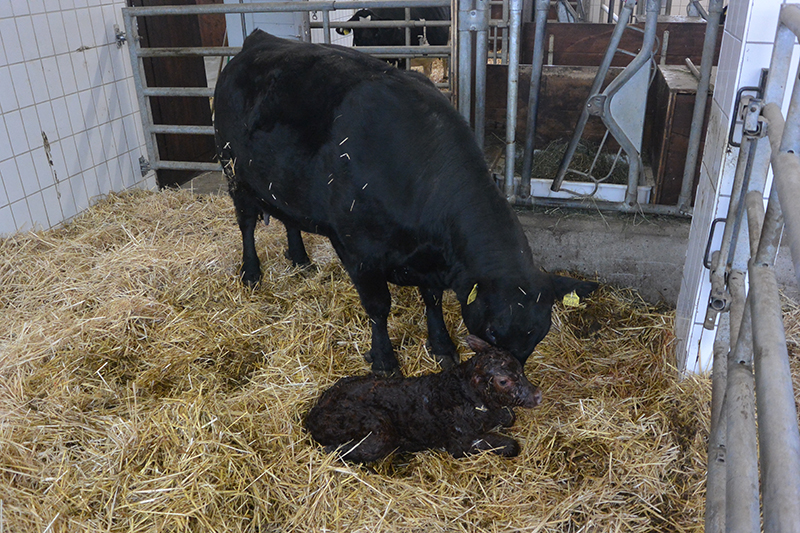There are currently around 220,000 suckler cows kept in Austria, which corresponds to around a third of all cows kept (2010: approx. 270,000 suckler cows; 2010-2015: -20%).
Suckler cow farming plays an important role in maintaining the cultural landscape, especially in the Austrian grassland areas, and due to extensive meat production without any significant use of concentrated feed (= “meat from grass”), there is no food competition with humans. Due to the abolition of the suckler cow premium, suckler cow farmers are faced with new challenges. You have to optimize operational processes and, above all, increase space efficiency. Good companies use their resources such as feed base, animal genetics and marketing opportunities efficiently, coupled with good management. The demands on the suckler cow farmer are becoming ever greater and an economical, functioning suckler cow is becoming more and more important. Problem-free and long-lasting suckler cows with good functional characteristics (udders, claws, maternal instinct, etc.), in pure or cross-breeding, are the basis for business success. In Austria, around 80% of the suckler cows are Simmental cows from dairy farming. However, Simmental cattle are increasingly developing into dairy cattle. But are good dairy cows also good mother cows? Good and economical suckler cows need good fertility and longevity, correct feet and legs, a good pelvic length, sufficient milk and a high-set udder. The basis for such cows could be created by crossing dairy breeds with meat breeds (e.g. Angus). When dairy cattle are crossed with a fattening breed, the heterosis effect manifests itself in very healthy and vital calves and therefore also vital mother cows. There is little documentation or hardly any research results for advice. Recommendations for practice and teaching (schools and universities) should be derived from the results of this project.
TEST PLAN:
- Crossing the Simmental or Holstein Friesian breeds with Angus as mother cows
- All cross partners in pure breeding + crosses = 5 genetic groups (HF, FV, AA, HFxAA, FVxAA)
- Why Angus?:
– Worldwide distribution, good availability
– Strong maternal instinct and good mothering characteristics
– Calving ease
– Polled
– Good forage utilization
– Very good meat quality
WORK PLAN:
- Mating all mother cows with Limousin bulls
(approx. 3 - 4 different bulls, artificial insemination) - At least 9 calves per experimental group = 3 calving periods
- 1 new mother cow per group and year = higher number of cows
- Young beef production: Slaughter of animals aged less than 1 year;
Minimum weights: female animals 350 kg and castrated male animals (oxen) 380 kg - Keeping in a free-stall barn (low-roof barn with feeding aisle) with a separate area for the calves (calf hatch)
- Feeding exclusively with hay and grass silage (calves only receive young, good calf hay in addition to milk)
- Examinations of suckler cows
- feed intake
- feed ingredients
- live weight development
- body condition and back fat thickness
- metabolic parameters
- fertility (insemination index, calving interval...)
- milk quantity
- milk ingredients - Examinations of young animals:
– feed intake (from around the 120th day of life)
– feed ingredients
– feed conversion
– live weight development (daily weight gain)
– back fat thickness (assessment of readiness for slaughter)
– fattening performance
– slaughter performance
meat quality
– fatty acid pattern
Research paper title:
"Pasture ox fattening without concentrated feed - influence of pasture stocking density on area efficiency and performance"
"Impact of stocking rate on performance and efficiency of steers fattened on pasture without concentrate supplementation"
Project management:
Priv.Doz. Dr. Andreas Steinwidder , Bio-Institut HBLFA Raumberg-Gumpenstein
Project staff HBLFA Raumberg-Gumpenstein: DI Walter Starz, Dr. Margit Velik, Dr. Leopold Podstatzky, Ing. Anton Schauer, Johann Häusler, Hannes Rohrer and Rupert Pfister
Cooperation partner University of Natural Resources and Life Sciences Vienna:
NN (Master's thesis)
Crossbreeding in suckler cows - effects of breed or crossbreeding on suckler cow and calf
Häusler Johann (2016 - 2021)







